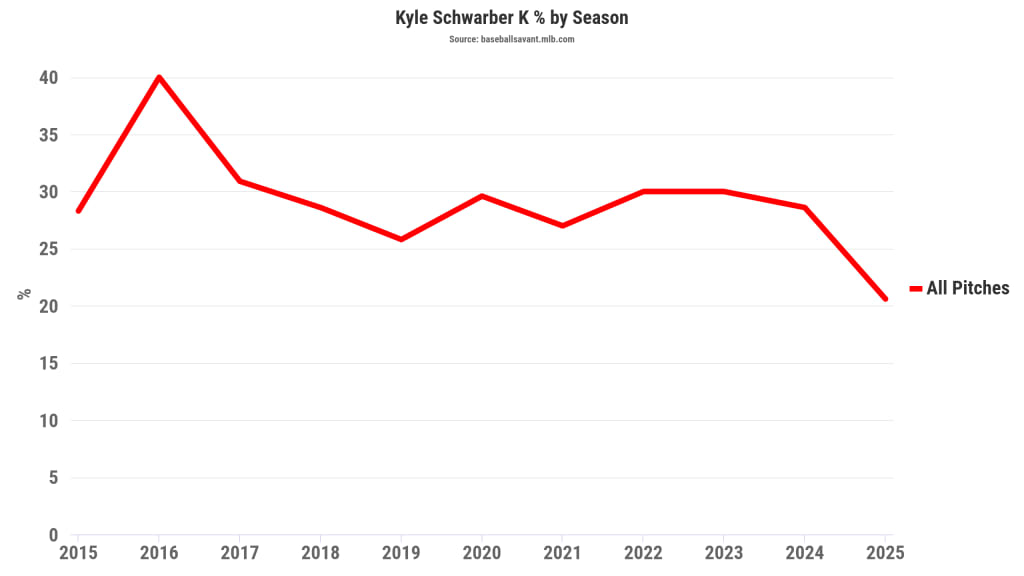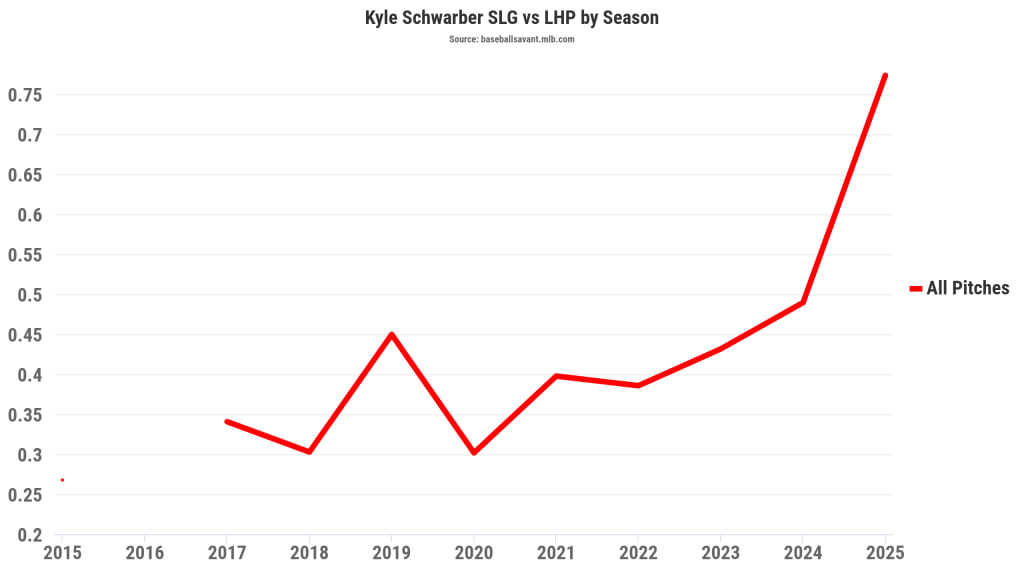Phillies slugger Kyle Schwarber is a curious case.
Since Schwarber joined Philadelphia prior to the 2022 season, only Aaron Judge has hit more homers. Only Juan Soto and Judge have tallied more walks. Yet Schwarber has rarely entered conversations about the game’s elite hitters.
To be fair, there was some reason for that prior to this season. Sure, the power and patience have always been there. Some advanced metrics even suggested Schwarber belonged in that top tier previously. But on the surface, something was missing.
Schwarber, though, might just change the perception in 2025. The veteran has taken his offensive game to new heights in his age-32 season, a well-timed development as free agency looms.
Prior to his 0-for-4 in Game 1 of Wednesday's doubleheader against the Cardinals, the left-handed bopper had reached base safely in every game this year, running his on-base streak to 47 games going back to 2024, among the longest in Phillies history. (As for Game 2? He homered, of course.) Schwarber's slashing .261/.393/.580 with 15 home runs and 30 walks on the season.
While Schwarber has had similar hot streaks in the past, this is his best 43-game start to a season in many respects, setting the stage for what might be a career year.
Granted, the veteran was still decidedly above average over his first three seasons with the Phillies (129 OPS+), but he also had far too many unproductive plate appearances -- the product of a lofty strikeout rate. His batting average was just .221. And despite all the homers and walks, his wOBA checked in at .357, which ranked outside the top 20 among qualifiers.
Phillies manager Rob Thomson summed up Schwarber's evolution succinctly on Saturday.
“I see him now as a complete hitter,” Thomson said. “He has big-time power, but he’s been really impressive overall through this stretch."
Here are three reasons why Thomson is absolutely right -- this is the most complete version of Schwarber we’ve seen.
All stats below are through Tuesday.
1. He’s become a tougher out when pitchers have the advantage
Offense generally declines when pitchers get ahead in the count, and that was certainly true for Schwarber in 2022-23, when he hit just .136 with a .288 slugging percentage in those situations. But after improving to a .230 average and .449 SLG last season, he has taken it to another level in 2025 (.277 AVG, .596 SLG). Few hitters have been more dangerous this year when behind in the count.
Highest SLG when behind in the count
Minimum 40 PAs ending on those counts
- Pete Alonso: .674
- Fernando Tatis Jr.: .600
- Kyle Schwarber: .596
- Paul Goldschmidt: .552
- Javier Báez: .551
That jump owes something to the progress he's made with two strikes. In particular, the veteran has sharpened his two-strike swing decisions, showing less of a tendency to offer at bad pitches when pitchers have tried to put him away.
From 2022-24, Schwarber’s overall chase rate was 21.4%. With two strikes, though, his chase rate rose to 32.4% -- still much better than the MLB average in those situations, but problematic nonetheless for a hitter who tends to work long at-bats (and therefore sees a lot of two-strike counts). It’s one of the reasons he struck out more times (612) than anyone else while notching a K-rate near 30.0% in that span.
In 2025, Schwarber has the lowest strikeout rate of his career at 20.3%, and not because he’s getting into two-strike counts less often. Rather, it’s because he has been less prone to swing at pitches outside the zone in those counts, dropping his chase rate to 25.0% with two strikes.
Lowest chase rate in two-strike counts, 2025
Min. 100 out-of-zone pitches seen with two strikes
- George Springer: 18.0%
- Michael Busch: 18.4%
- Rafael Devers: 18.8%
- Gavin Lux: 19.6%
- Luis Robert Jr.: 23.1%
- Kyle Schwarber: 24.8%
The subtle improvement has allowed Schwarber to trim his strikeout rate without sacrificing the traits that made him such a force to begin with. He's still racking up the homers and walks. Only now, with fewer K's.

Schwarber said he doesn't feel like he's been doing anything differently -- just sticking to his game plan.
“Obviously when you get into two strikes, you’re trying to, one, limit chase, but also two, feel like if you’re getting a pitch on the edges or around the zone or whatever it is, try to put it in play," he told reporters on Monday. "Good things can happen that way. But nothing’s really changing much.
"I feel like I’m just really trying to eliminate -- as much as I can -- their pitch and try to get to my pitch before that. Because not many good things happen with two strikes.”
2. You can’t beat him consistently with velocity anymore
For Schwarber, getting to “his” pitch typically has meant hunting for fastballs he can drive. He has 191 career home runs against the three fastball classifications -- four-seamers, sinkers and cutters.
In the past, though, Schwarber was often susceptible against higher-velocity four-seamers. Not this year.
Schwarber has a .318 average and .864 SLG against four-seamers thrown 95 mph or faster in 2025, with four home runs (tied with Ohtani for the MLB lead). His blast against Rockies right-hander Victor Vodnik's 98.7 mph four-seamer on March 31 was the second-fastest pitch he's homered against during his career. It's a stark contrast to 2022-24, when he hit .180 with a .403 SLG on 95+ mph four-seamers.
Against four-seamers overall? He has six homers and owns a career-high .708 SLG, one of the best marks in MLB.
Highest SLG against four-seam fastballs, 2025
Minimum 50 PAs ending on four-seamers
- James Wood: .957
- Corbin Carroll: .922
- Gavin Sheets: .755
- Kyle Schwarber: .708
- Shohei Ohtani: .667
3. He’s continued to make strides against lefties
Early in his career, Schwarber often found himself riding the pine against lefties, and for good reason. During his entire six-year tenure with the Cubs, he tallied just 435 plate appearances in those matchups, over which he posted a .197/.301/.348 slash.
However, since his time with Chicago came to an end when the team non-tendered him after the 2020 campaign, Schwarber has seen far more playing time against same-sided pitchers. And with increased exposure has come improved performance, leading to this year’s eruption: he’s got a .321/.446/.774 slash with seven homers against left-handed pitching in 2025.

No left-handed batter who has taken at least 30 PAs against southpaws has been more destructive.
Highest SLG in lefty-lefty matchups, 2025
Minimum 30 lefty-lefty PAs
- Kyle Schwarber: .774
- JJ Bleday: .667
- Shohei Ohtani: .623
- Jung Hoo Lee: .622
- Kyle Tucker: .608
For Schwarber, it's the culmination of years of work aimed at reaching a point where those matchups no longer feel any different.
“You try to get to that point where you make it just a pitcher," he said. "You don’t really view it as left-left, right-handed pitcher, whatever it is. You just view yourself as hitting. … You just try to take that stigma away and just try to have an at-bat.”
Add it all up and the results reflect the hitter he’s long shown the potential to be. His underlying numbers and surface stats are finally in agreement.
Among those with at least 150 plate appearances in 2025, Schwarber’s .432 expected wOBA -- reflecting his quality of contact, with his actual strikeout and walk numbers factored in -- ranks sixth. Meanwhile, his .422 wOBA -- reflecting his actual results -- ranks fourth.
Schwarber’s offensive evolution isn’t just a win for the Phillies. It’s a statement to the rest of the league -- and to every front office watching ahead of his next run at free agency.
If this is what Schwarber looks like over the next few months, teams won’t see him as an all-or-nothing slugger. They’ll see him as a lineup cornerstone.
MLB.com Phillies beat reporter Todd Zolecki contributed to the reporting of this article.
